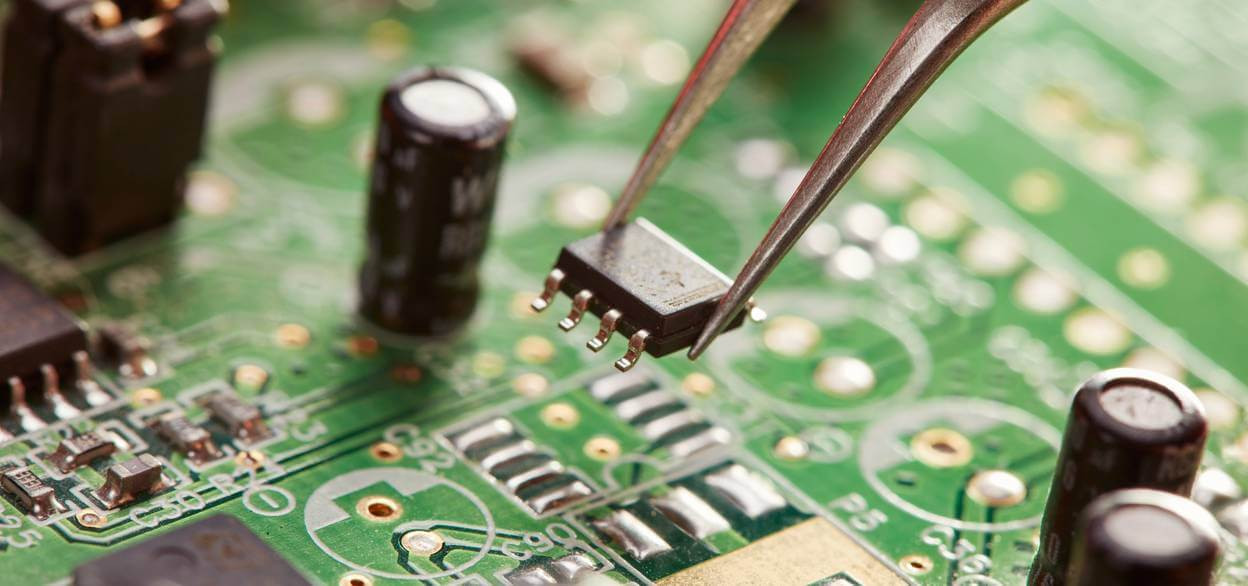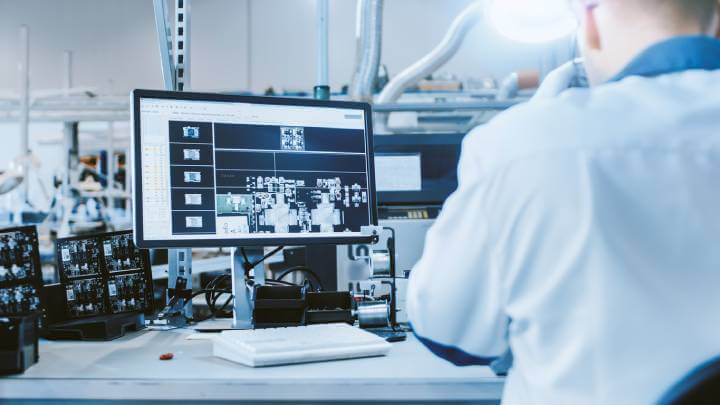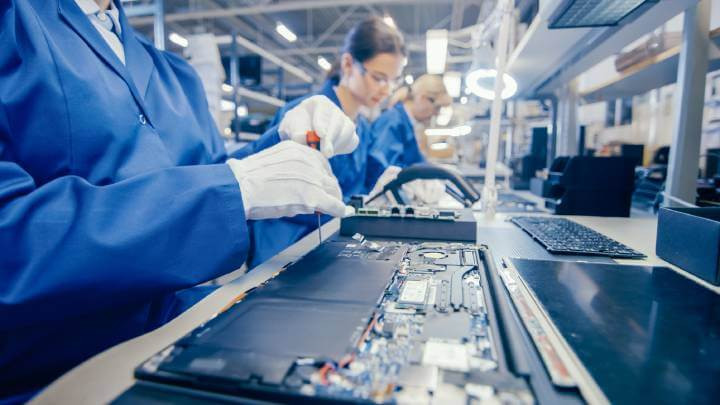What is a Microchip: Overview of Its Role in Technology
04-01-2024 | By Robin Mitchell
![]()
Table of Contents:
- Introduction: Unraveling the Microchip's Enduring Legacy
- The History of Microchips: Charting the Course of Innovation
- Composition of Microchips: The Building Blocks of Innovation
- Manufacturing Process of Microchips: Time-Honored Techniques and Principles
- Functionality of Microchips: The Core of Modern Technology
- Current Trends and Future of Microchip Technology: A Long-Term Perspective
- Conclusion: The Timeless Journey of Microchip Technology
Introduction: Unraveling the Microchip's Enduring Legacy
Microchips, those unassuming slivers of silicon, are more than just components; they are the linchpins of modern technology. Fundamentally, a microchip, or an integrated circuit, is a convergence of numerous electronic elements—transistors, resistors, capacitors—meticulously integrated onto a tiny silicon chip. This integration represents more than just a triumph in making things smaller; it stands as a powerful demonstration of human creativity and skill in the field of electronics.
The true value of microchips lies not in their physical form but in their pervasive influence across various technological domains. From the smartphone in your pocket to the satellites orbiting our planet, microchips are the unsung heroes, silently orchestrating the digital symphony that underpins our daily lives.
As we delve into the workings of microchips, this article aims to transcend the fleeting trends of the tech world, focusing instead on the enduring principles that make microchips a cornerstone of innovation. We'll explore their fundamental concepts, steering clear of ephemeral specifics, to appreciate their lasting impact on technology. Join us on this journey to uncover the timeless essence of microchips, a narrative that resonates as much with the curious novice as it does with the seasoned engineer.
The History of Microchips: Charting the Course of Innovation
The journey of microchip technology is a fascinating saga of human ingenuity and relentless progress. It's a story that transcends specific dates and periods, focusing instead on the lasting impact of key developments and the visionaries who made them possible. For a more in-depth exploration of this journey, you can delve into the comprehensive history of microchips, which provides a detailed account of these groundbreaking innovations.

The Genesis of an Idea
The concept of the microchip began as a bold vision: to integrate multiple electronic components onto a single, compact substrate. This idea was revolutionary, setting the stage for a new era in electronics where miniaturization and efficiency would become paramount.
The Transistor: A Cornerstone of Microchip Technology
The development of the transistor marked a significant milestone in the microchip's history. Replacing the bulky vacuum tubes of earlier times, transistors provided a smaller, more efficient way to control electrical signals, paving the way for the complex circuitry we see in today's microchips.
Silicon: The Material of Choice
The selection of silicon as the primary material for microchip fabrication was a pivotal moment in the technology's evolution. Silicon's semiconducting properties and abundance made it an ideal choice, significantly influencing the direction of future electronic innovations.
The Evolution of Integration and Complexity
As microchip technology advanced, the focus shifted towards integrating an increasing number of components onto each chip. This drive towards greater complexity and functionality marked a key transition, transforming microchips from simple assemblies to the sophisticated, multi-functional units that are central to modern technology.
The Legacy of Innovators
The history of microchips is also a tribute to the visionaries and innovators whose contributions have had a profound and lasting impact. These pioneers didn't just create technological products; they sparked revolutions in thought and practice, laying the foundations for the digital age.
The history of microchips is a narrative of ideas, materials, and human ambition. It's a story that continues to evolve, driven by the same spirit of innovation that marked its beginnings. As we delve deeper into the workings of microchips in the subsequent sections, we carry with us the understanding that this technology, though ever-changing, is rooted in a rich legacy of creativity and vision.
Composition of Microchips: The Building Blocks of Innovation
Understanding the composition of microchips is key to appreciating their functionality and the ingenuity behind their design. For an in-depth exploration, the composition of microchips article provides detailed insights into the materials that have been staples in microchip manufacturing. In this section, we'll focus on these enduring elements and the reasons behind their consistent use, offering perspectives that remain relevant amidst technological advancements.

Silicon: The Quintessential Semiconductor
At the heart of almost every microchip is silicon, a material chosen for its semiconducting properties. Silicon's ability to conduct electricity under certain conditions is fundamental to the binary logic of digital computing. Its abundance and cost-effectiveness also make it a practical choice for widespread use in the industry.
Metals: Conducting the Digital Symphony
Metals such as copper, aluminum, and gold are indispensable in microchip design. Copper and aluminum are primarily used for their excellent electrical conductivity, which is crucial for the transmission of signals within the chip. Gold, despite its higher cost, is employed in areas requiring enhanced corrosion resistance and reliability, particularly in delicate connections.
Insulators and Dielectrics: Ensuring Precision and Isolation
Insulating materials like silicon dioxide and various polymers are the unsung heroes in a microchip's architecture. These materials are essential for preventing unwanted electrical conductivity, allowing each component on the chip to operate independently and effectively.
Doping Elements: Customizing Electrical Characteristics
Doping, the addition of impurities to silicon, is a critical process in microchip manufacturing. It involves using elements like phosphorus and boron to modify the electrical properties of silicon, enabling the creation of p-type and n-type semiconductors, which are crucial for the functioning of diodes and transistors.
Rare Earth Elements: Enhancing Specific Functions
While used in smaller quantities, rare earth elements are vital for certain microchips, enhancing specific functionalities such as the efficiency of LEDs or certain types of memory storage.
The composition of microchips is a testament to the intricate balance of materials science and electrical engineering. Each material is chosen for its unique properties and role in the chip's overall performance, reflecting a blend of technological capability and economic practicality. As we delve further into the world of microchips, these materials stand as the foundational elements of an ever-evolving field.
Manufacturing Process of Microchips: Time-Honored Techniques and Principles
The manufacturing process of microchips is a marvel of modern engineering, involving precision and complexity at a microscopic scale. For a detailed account of this process, the manufacturing process of microchips article offers an extensive exploration. In this section, we'll focus on the fundamental steps and enduring principles of microchip manufacturing, steering clear of cutting-edge methods that may soon become obsolete.
![]()
Step 1: Silicon Wafer Preparation
The journey of a microchip begins with the preparation of silicon wafers, the base material for most chips. Silicon, derived from sand, is purified and crystallized into ingots. These ingots are then sliced into thin wafers, providing the canvas upon which circuits will be built. This process sets the stage for the intricate work that follows, with the purity and quality of the silicon wafer being crucial for the chip's performance.
Step 2: Photolithography – The Art of Miniaturization
Photolithography is a key step in defining the microchip's circuitry. It involves coating the silicon wafer with a light-sensitive material called a photoresist. A mask with the desired circuit pattern is then used to expose parts of the photoresist to light. The exposed areas undergo a chemical change, allowing the underlying silicon to be etched or doped. This step is repeated multiple times to build up the complex layers of the microchip.
Step 3: Etching – Sculpting the Circuitry
Etching is the process of removing selected areas of the silicon wafer to create the microchip's circuit paths. This can be achieved through various methods, but the principle remains the same: precisely removing material to leave behind the desired structure. The accuracy of this process is vital for the functionality of the final product.
Step 4: Doping – Tailoring Electrical Properties
Doping involves introducing small amounts of impurities into the silicon wafer to alter its electrical properties. This step is crucial for creating the p-type and n-type regions essential for the transistors in the microchip. The precision and control in doping determine the chip's electrical characteristics.
Step 5: Metallization and Packaging
The final steps involve depositing metal layers to form connections between the chip's components and then encapsulating the delicate structure in a protective package. This packaging not only safeguards the chip but also provides the means for it to be integrated into larger electronic systems.
The manufacturing process of microchips is a testament to the precision and innovation inherent in electronics engineering. While the industry continues to evolve, these fundamental steps remain the bedrock of microchip production, embodying principles that have stood the test of time. As we move forward, it's these enduring techniques that continue to underpin the remarkable world of microchip technology.
Functionality of Microchips: The Core of Modern Technology
Understanding the core functions of microchips is crucial to grasping their pivotal role in the advancement of technology. For an in-depth exploration, the functionality of microchips article provides detailed insights. This section aims to shed light on these functions in a broad sense, applicable to a wide range of devices over time, and discuss the role of microchips in propelling technology forward in general terms.

Digital Processing: The Brain of Electronic Devices
Microchips are essentially the brains of electronic devices, responsible for digital processing. They interpret and execute instructions through electrical signals, controlling a diverse array of functions, from basic operations in digital watches to complex computations in advanced computing systems.
Signal Processing and Management
A key function of microchips is managing and processing signals, whether for audio, video, or data communication. They adeptly convert analog signals to digital formats, process and enhance these signals, and manage data flow in communication networks. This versatility is crucial in everything from multimedia devices to complex telecommunication systems.
Storage and Memory: The Keepers of Data
Microchips serve a vital role in data storage and memory. They store operational instructions and temporary data, essential for the functioning of computing devices. This ability to retain and access critical data and instructions is foundational to the operation of modern electronic devices.
Control and Interface: The Command Center
In electronic devices, microchips act as control centers, interfacing with various components and peripherals. They manage inputs from user interfaces and control outputs to displays and speakers, playing a critical role in ensuring devices respond accurately and efficiently to user interactions.
Power Management: Maximizing Efficiency
Especially in portable and battery-operated devices, microchips are key to power management. They regulate power usage to enhance energy efficiency and extend battery life, a function that has become increasingly important in our mobile-centric world.
The functionality of microchips, encompassing processing, signal management, storage, control, and power management, highlights their indispensable role in a multitude of technologies. These core functions, transcending specific devices and time periods, establish microchips as fundamental components in the ongoing evolution of the digital era.
Current Trends and Future of Microchip Technology: A Long-Term Perspective
Exploring the long-term trends in microchip technology offers a glimpse into the general direction of future innovations, steering clear of specific, transient forecasts.
Miniaturization: The Persistent Drive for Compact Efficiency
The quest for smaller, more efficient chips has been a consistent trend in microchip technology. This drive towards miniaturization is not just about reducing size but also about enhancing efficiency and capacity. As we look ahead, this trend is likely to persist, with microchips becoming increasingly compact while offering greater functionality.
Integration: Merging Technologies Seamlessly
Integration is a key trend where microchips are evolving to become multifunctional, combining capabilities that were once distinct. This trend suggests a future where microchips will not only be central to computing but will also integrate more seamlessly with various technologies, from communication networks to sensory systems.
Energy Efficiency: A Paramount Concern
With the rise of portable and ubiquitous electronic devices, energy efficiency is becoming increasingly important. Future innovations in microchip technology are likely to focus more on reducing power consumption and enhancing battery life, making devices more sustainable and user-friendly.
Material Innovation: Exploring Beyond Silicon
While silicon remains the foundation of microchip technology, the exploration of new materials is gaining momentum. These materials might offer improved performance, efficiency, or new functionalities. Future developments are expected to see continued research and innovation in materials science, significantly influencing microchip evolution.
AI and Machine Learning Integration
The integration of artificial intelligence and machine learning with microchip technology is a growing trend. Future microchips are likely to incorporate more AI and machine learning capabilities, enabling smarter, more autonomous devices. This trend points towards a future where microchips not only process data but also learn and adapt, enhancing their functionality and application.
These long-term trends in microchip technology—miniaturization, integration, energy efficiency, material innovation, and AI integration—provide a framework for envisioning the future. While the specifics may be uncertain, the potential and possibilities in the evolution of microchips are undoubtedly vast and promising.
Conclusion: The Timeless Journey of Microchip Technology
As we reach the end of our exploration into the world of microchips, it's clear that their journey is marked by a series of timeless aspects and enduring principles. From their fundamental composition and manufacturing processes to their core functionalities and the broad trends shaping their future, microchips stand as a testament to human ingenuity and the relentless pursuit of technological advancement.
The Enduring Essence of Microchips
At their core, microchips embody the spirit of innovation. Their journey from a conceptual breakthrough to an indispensable component in countless devices highlights a remarkable evolution. The materials that form their foundation, the intricate processes that shape their creation, and the diverse functionalities they offer, all speak to a technology that has been, and will continue to be, central to the digital age.
Microchips: The Heartbeat of Modern Technology
The ongoing importance of microchips in technology cannot be overstated. They are the building blocks of the digital world, powering everything from the simplest gadgets to the most complex computing systems. Their role in advancing technology is not just a historical fact but a continuing reality, as they adapt and evolve to meet the ever-changing demands of the modern world.
A Gateway to Deeper Understanding
For those eager to delve deeper into the fascinating world of microchips, the linked articles provide a wealth of in-depth, evergreen information. These resources offer a more comprehensive look at each aspect of microchip technology, from its rich history and fundamental composition to the innovative manufacturing processes and the broad trends shaping its future.
In closing, the story of microchips is one of constant evolution, driven by a blend of scientific curiosity and practical necessity. As we look to the future, it's clear that microchips will continue to play a pivotal role in shaping technology, reflecting the timeless nature of their innovation and impact.

